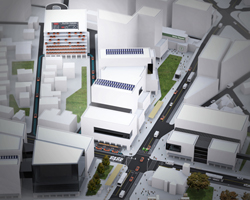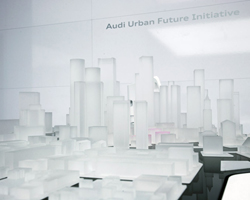team mexico city wins the AUDI urban future award 2014, presented in berlin
image © designboom
‘the next leap in mobility’ was the motto of the 2014 AUDI urban future award. this year, the initiative invited four international multidisciplinary teams composed of ethnographers, IT specialists, product designers, urban planners, natural scientists, sociologists, etc. – from berlin, boston, mexico city and seoul – to research and develop schemes responding to problems related to transportation in cities. the four proposals were first presented in berlin in april. though distinct in their own rights, reacting to four diverse parts of the world, they all express one underlying commonality: to improve mobility in large, densely developed areas and enhance residents’ quality of life. AUDI urban future award 2014 has announced that TEAM MEXICO CITY as come out on top with their proposal of an operating system for the city.
TEAM MEXICO CITY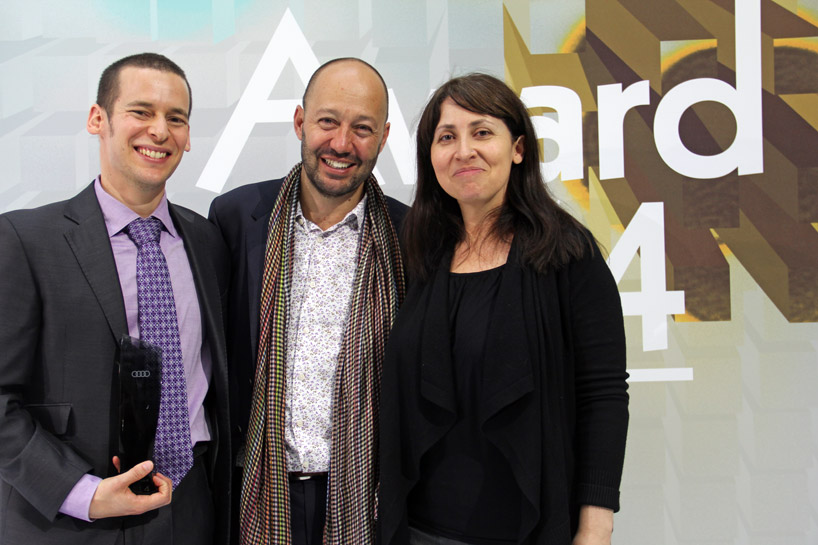
TEAM MEXICO CITY (left to right): carlos gershenson, data analyst; jose castillo, architect & city planner; gabriella gomez-mont, innovator & corporate consultant
image © designboom
crowdsourcing – how smart data helps to challenge permanent traffic congestion
it is TEAM MEXICO CITY’s belief that big cities provide many sources of data. therefore, they elaborated on this observation by exploring and harnessing crowd-sourcing as a means of solving the problem of traffic hold-ups. they asked questions such as: what contributions can citizens, businesses and the administration make to improve the traffic situation? as improvements of mobility by infrastructure is limited, they propose that we must make it more like a living system. that is, mobility should be adaptive, learning, robust and self-organizing.
AUDI urban future award 2014 – team mexico city
video © AUDI urban future initiative
TEAM MEXICO CITY is analyzing data streams about traffic flows and mobility behavior, in order to find solutions for the future of urban mobility. with this data, they think that car congestion can be regulated to improve navigation around the city. ‘can cars help solve the traffic problems which they have caused? in our project, we test new forms of collaboration between government, companies, science and residents to stimulate a new culture of mobility – powered by mobile technologies and data.’ says jose castillo

TEAM MEXICO CITY’s proposal sees the public sharing its date to improve traffic flows
image © AUDI urban future initiative
22 million people, nine million vehicles and a completely inadequate road network: mexico city is the world’s most daunting metropolis for commuters. 265,000 of them spend three hours each day travelling to and from their place of work in the santa fe business district. by way of comparison: in 1904 trams moved through the city at 10 km/h, and today commuters progress at an average of less than 6 km/h during rush hour.
‘our city needs an operating system to help people make informed decisions about their mobility choices and to support public officials and policy makers in finding long-term solutions for the megacity. our proposal works in real time and is extremely low-cost.’ states jose castillo.

twitter usage in mexico city
image © AUDI urban future initiative
TEAM MEXICO CITY’s proposal is an operating system for urban mobility that provides information in real time about weak points in the traffic network and thus makes solutions possible based on data from city departments, private companies, and twitter or foursquare. by this means the traffic situation in mexico city can be assessed as a whole. the first version of the data platform went online in september 2014. commuters can share their own mobility behavior and donate information on their movements via a website and an app.

data donors
image © AUDI urban future initiative
the information from the public data pool helps AUDI and the city government to understand which technologies can optimize the flow of traffic (e.g. car-to-x technologies like ampel info online). if traffic flows more efficiently one day, people will not only regain flexibility; fewer cars on the roads will also mean more space for the city and a better quality of life for everyone. see more on TEAM MEXICO CITY’s winning proposal here.
team mexico city concept presentation at AUDI urban future award ceremony 2014 in berlin
video © AUDI urban future initiative
TEAM BERLIN
TEAM BERLIN (left to right): arndt pechstein, biochemist & neuroscientist; max schwitalla, architect & city planner; paul friedli, innovator & transit management expert
image © designboom
‘can public and private transport become one interlinked system capable of individual point-to-point traffic on a premium level? we aim to transform the traditional city into a flexible just-in-time system based on swarming dynamics.’ – TEAM BERLIN

multimodal transportation with flywheels
image © AUDI urban future initiative
from public transportation to individual transportation
TEAM BERLIN’s project focuses on tegel airport – recently located to a more efficient and spacious site – as its subject. situated 15 minutes outside berlin, it is considered to be the metropolis’s largest urban planning development. for this reason it has been given the nickname ‘urban tech republic’, and is quickly becoming a hotspot for knowledge workers and university students. however, it still has no direct transport network linking it to the city. this shift in movement is expected to affect berlin’s mobility system, with traffic volumes bound to increase. as a result, drivers on the autobahn will experience an increase in the already congested road connections. TEAM BERLIN seeks to find ways of connecting the airport area with the greater city in a seamless and intuitive way. see more on TEAM BERLIN’s proposal here.

interior of a decoupled flywheel
images © AUDI urban future initiative
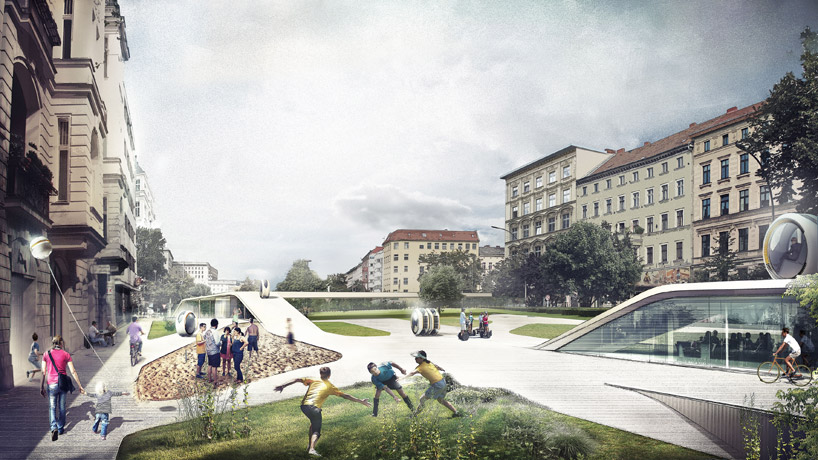
urban mobility landscape
image © AUDI urban future initiative
TEAM SEOUL
TEAM SEOUL (left to right): taigyoun cho, ubiquitous city planner; sung gul hwang, ethnographer & experience strategist; yeongkyu yoo, product designer & creative director
image © designboom
‘we want to find answers to the question of what role will the car play in the future by redefining it, not just as a status symbol, but as the medium for society and the environment as a whole.’ – TEAM SEOUL

cars as the ultimate interfaces to a smart city
TEAM SEOUL was working on the philosophy that ‘reality and virtuality will merge’. asking ‘what role can automobiles play in a society that has stylized entertainment as the most important cultural asset, and has thoroughly embraced digital communication?’ back in the 1960s the south korean capital’s gangnam district ranked among the poorest in the world, but is now churning out technological innovations at lightning speed. TEAM SEOUL uses an ethnographical approach to address this issue, turning to the behavioral patterns of the area as a case study to investigate the automobile’s leap into the future. see more on TEAM SEOUL’s proposal here.



images © AUDI urban future initiative
TEAM BOSTON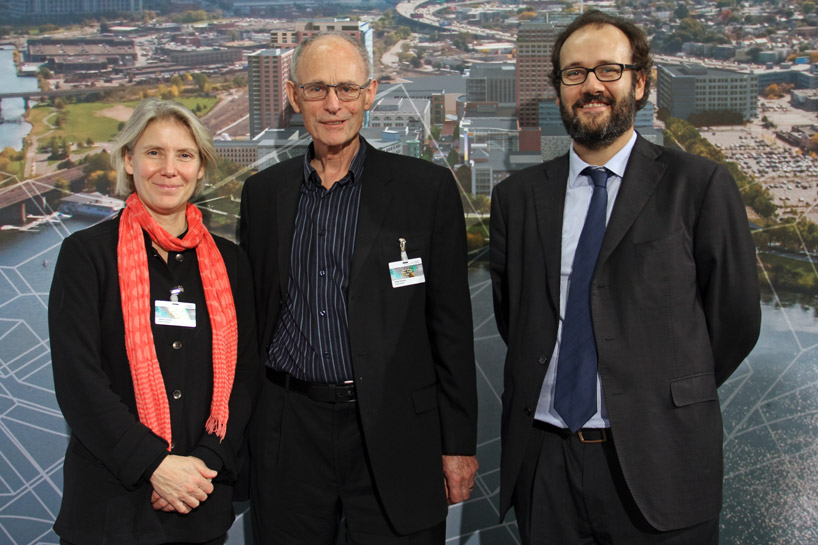
TEAM BOSTON (left to right): janne corneil, urban planner & designer; philip parsons, strategic planner & corporate consultant; federico parolotto, mobility expert
image © designboom
‘the coming mobility revolution can be a tragedy or a triumph for american cities. our mobility marketplace will stimulate innovation and competition, while improving user experience across all modes of mobility, and enhancing urban life.’ – TEAM BOSTON

4M using big data
image © AUDI urban future initiative
making mobility opportunities calculable for urban-planning purposes
with the thesis ‘the boundaries between mobility and immobility will be removed’, TEAM BOSTON used somerville, a community in the boston metropolitan area as a case study to present their proposal. overtime, the district has morphed into new england’s most densely populated area, as well as one of the most rapidly-evolving areas, thanks to its cultural vitality and proximity to the massachusetts capital. TEAM BOSTON sought to look at how automobile technologies can assist in making gains of space and infrastructure in urban centers. see more on TEAM BOSTON’s proposal here.

win-win-win situation 4M
image © AUDI urban future initiative

all winners of the AUDI urban future award 2010, 2012 & 2014 at the award ceremony
left to right: jürgen mayer h., meejin yoon, eric höweler, jose castillo, gabriella gomez-mont, carlos gershenson
image courtesy AUDI urban future initiative

eric höweler of architecture office höweler + yoon from boston, winners of the AUDI urban future award 2012 with their boswash project
portrait © designboom

among the visitors: xiaodu liu of urbanus architecture and design from china participated together with NODE architcture their project at the AUDI urban future award 2012
portrait © designboom

hubert klumpner of são paulo-based firm urban-think tank presented the ‘urban parangolé the mobile village‘ at the AUDI urban future award 2012, in istanbul
portrait © designboom
AUDI urban future initiative (10)
PRODUCT LIBRARY
a diverse digital database that acts as a valuable guide in gaining insight and information about a product directly from the manufacturer, and serves as a rich reference point in developing a project or scheme.

